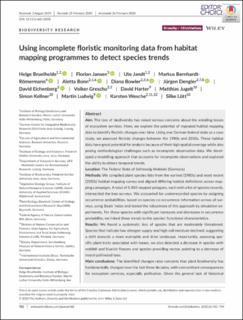Bitte benutzen Sie diese Kennung, um auf die Ressource zu verweisen:
https://doi.org/10.21256/zhaw-20213| Publikationstyp: | Beitrag in wissenschaftlicher Zeitschrift |
| Art der Begutachtung: | Peer review (Publikation) |
| Titel: | Using incomplete floristic monitoring data from habitat mapping programmes to detect species trends |
| Autor/-in: | Bruelheide, Helge Jansen, Florian Jandt, Ute Bernhardt‐Römermann, Markus Bonn, Aletta Bowler, Diana Dengler, Jürgen Eichenberg, David Grescho, Volker Harter, David Jugelt, Matthias Kellner, Simon Ludwig, Martin Wesche, Karsten Lütt, Silke |
| et. al: | No |
| DOI: | 10.1111/ddi.13058 10.21256/zhaw-20213 |
| Erschienen in: | Diversity and Distributions |
| Band(Heft): | 26 |
| Heft: | 7 |
| Seite(n): | 782 |
| Seiten bis: | 794 |
| Erscheinungsdatum: | 29-Jun-2020 |
| Verlag / Hrsg. Institution: | Wiley |
| ISSN: | 1366-9516 1472-4642 |
| Sprache: | Englisch |
| Fachgebiet (DDC): | 333.7: Landflächen, Naturerholungsgebiete |
| Zusammenfassung: | Aim: The loss of biodiversity has raised serious concerns about the entailing losses of ecosystem services. Here, we explore the potential of repeated habitat mapping data to identify floristic changes over time. Using one German federal state as a case study, we assessed floristic changes between the 1980s and 2010s. These habitat data have great potential for analysis because of their high spatial coverage while also posing methodological challenges such as incomplete observation data. We developed a modelling approach that accounts for incomplete observations and explored the ability to detect temporal trends. Location: The Federal State of Schleswig‐Holstein (Germany) Methods: We compiled plant species lists from the earliest (1980s) and most recent (2010s) habitat mapping survey and aligned differing habitat definitions across mapping campaigns. A total of 5,503 mapped polygons, each with a list of species records, intersected the two surveys. We accounted for underrecorded species by assigning occurrence probabilities, based on species co‐occurrence information across all surveys, using Beals' index and tested the robustness of this approach by simulation experiments. For those species with significant increases and decreases in occurrence probability, we linked these trends to the species' functional characteristics. Results: We found a systematic loss of species that are moderately threatened. Species that indicate low nitrogen supply and high soil moisture declined, suggesting a shift towards a more eutrophic and drier landscape. Importantly, assessing specific plant traits associated with losses, we also detected a decrease in species with reddish and blueish flowers and species providing nectar, pointing to a decrease of insect‐pollinated taxa. Main conclusions: The identified changes raise concerns that plant biodiversity has fundamentally changed over the last three decades, with concomitant consequences for ecosystem services, especially pollination. Given the general lack of historical standardized data, our approach for trend analyses using incomplete observation data may be widely applicable to assess long‐term biodiversity change. |
| URI: | https://digitalcollection.zhaw.ch/handle/11475/20213 |
| Volltext Version: | Publizierte Version |
| Lizenz (gemäss Verlagsvertrag): | CC BY 4.0: Namensnennung 4.0 International |
| Departement: | Life Sciences und Facility Management |
| Organisationseinheit: | Institut für Umwelt und Natürliche Ressourcen (IUNR) |
| Enthalten in den Sammlungen: | Publikationen Life Sciences und Facility Management |
Dateien zu dieser Ressource:
| Datei | Beschreibung | Größe | Format | |
|---|---|---|---|---|
| 2020_Bruelheide-etal_Floristic-monitoring-data-to-detect-species-trends_DDI.pdf | 1.35 MB | Adobe PDF |  Öffnen/Anzeigen |
Zur Langanzeige
Bruelheide, H., Jansen, F., Jandt, U., Bernhardt‐Römermann, M., Bonn, A., Bowler, D., Dengler, J., Eichenberg, D., Grescho, V., Harter, D., Jugelt, M., Kellner, S., Ludwig, M., Wesche, K., & Lütt, S. (2020). Using incomplete floristic monitoring data from habitat mapping programmes to detect species trends. Diversity and Distributions, 26(7), 782–794. https://doi.org/10.1111/ddi.13058
Bruelheide, H. et al. (2020) ‘Using incomplete floristic monitoring data from habitat mapping programmes to detect species trends’, Diversity and Distributions, 26(7), pp. 782–794. Available at: https://doi.org/10.1111/ddi.13058.
H. Bruelheide et al., “Using incomplete floristic monitoring data from habitat mapping programmes to detect species trends,” Diversity and Distributions, vol. 26, no. 7, pp. 782–794, Jun. 2020, doi: 10.1111/ddi.13058.
BRUELHEIDE, Helge, Florian JANSEN, Ute JANDT, Markus BERNHARDT‐RÖMERMANN, Aletta BONN, Diana BOWLER, Jürgen DENGLER, David EICHENBERG, Volker GRESCHO, David HARTER, Matthias JUGELT, Simon KELLNER, Martin LUDWIG, Karsten WESCHE und Silke LÜTT, 2020. Using incomplete floristic monitoring data from habitat mapping programmes to detect species trends. Diversity and Distributions. 29 Juni 2020. Bd. 26, Nr. 7, S. 782–794. DOI 10.1111/ddi.13058
Bruelheide, Helge, Florian Jansen, Ute Jandt, Markus Bernhardt‐Römermann, Aletta Bonn, Diana Bowler, Jürgen Dengler, et al. 2020. “Using Incomplete Floristic Monitoring Data from Habitat Mapping Programmes to Detect Species Trends.” Diversity and Distributions 26 (7): 782–94. https://doi.org/10.1111/ddi.13058.
Bruelheide, Helge, et al. “Using Incomplete Floristic Monitoring Data from Habitat Mapping Programmes to Detect Species Trends.” Diversity and Distributions, vol. 26, no. 7, June 2020, pp. 782–94, https://doi.org/10.1111/ddi.13058.
Alle Ressourcen in diesem Repository sind urheberrechtlich geschützt, soweit nicht anderweitig angezeigt.